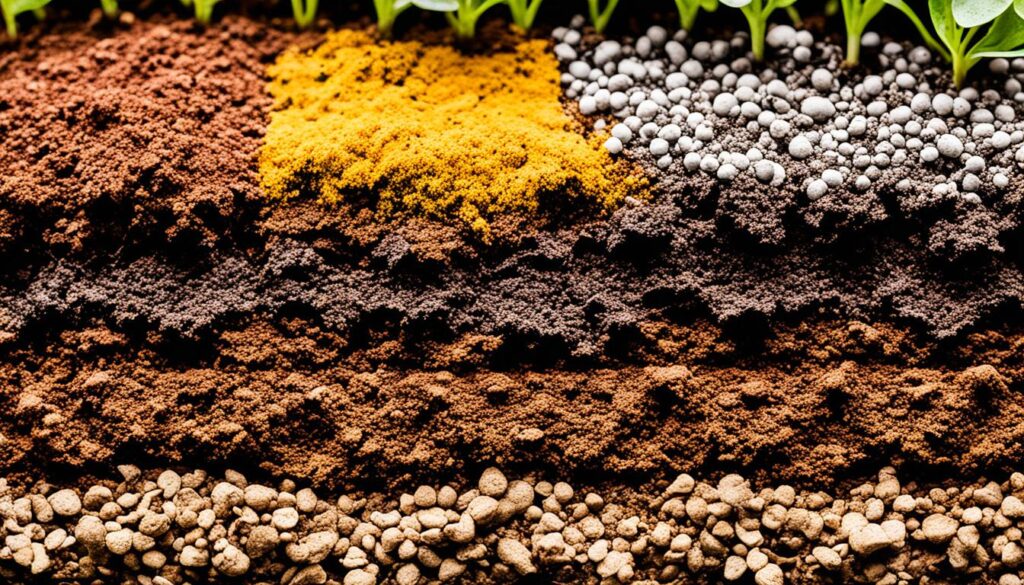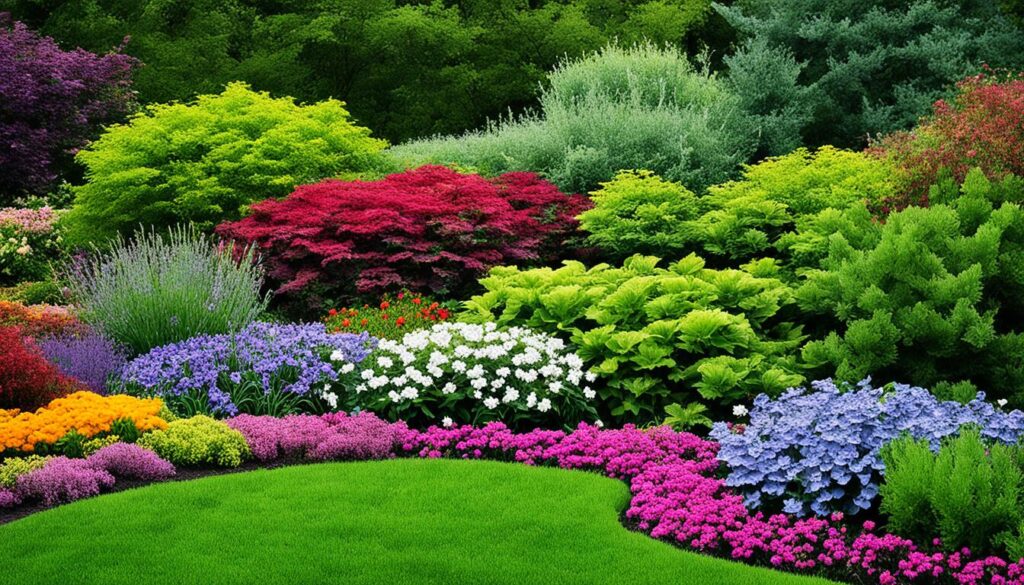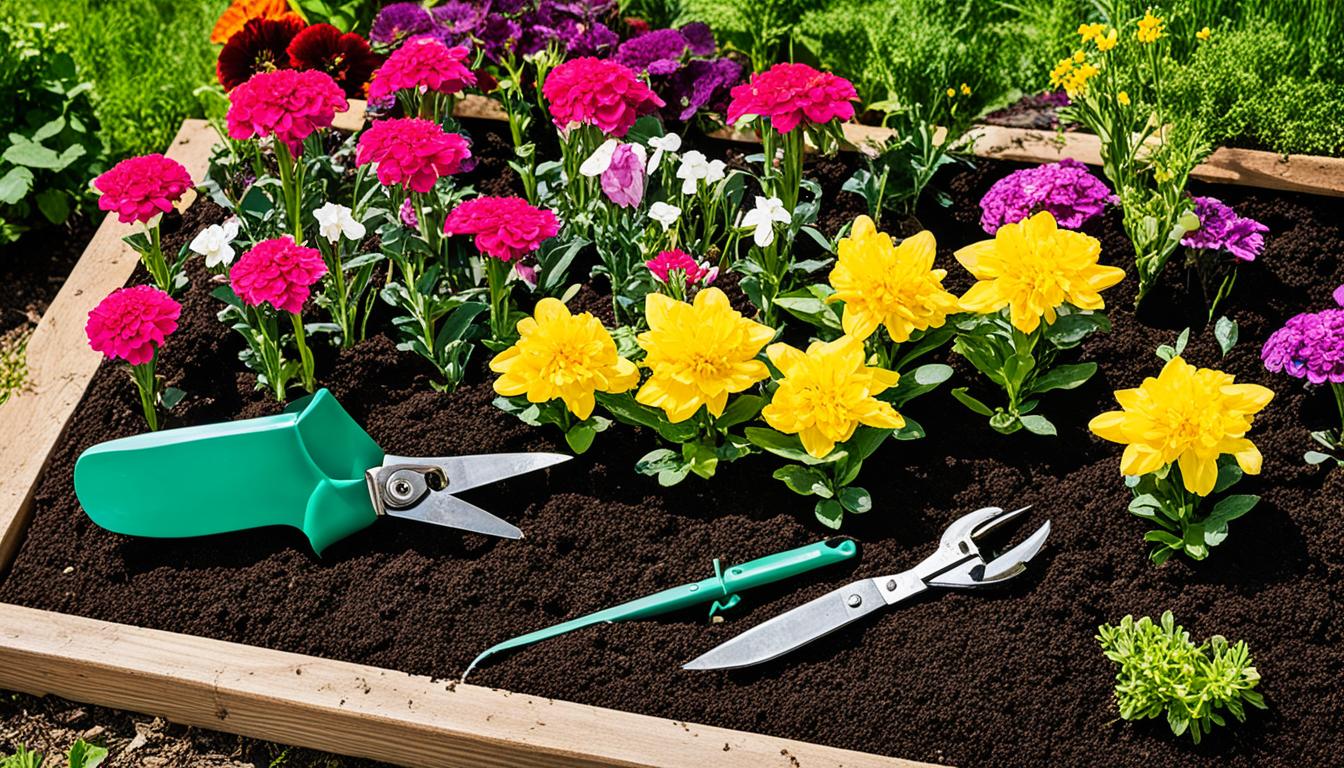Starting a flower garden can be tough, but these tips will make it simpler. They are great for both beginners and experts. These tips will guide you to make a beautiful, lively, and healthy garden that will bring you happiness.
Choose a sunny place with good drainage and easy access first. Flowers require a lot of sunlight to grow well. Evaluate your space to see if it gets enough sun during the day. This step is crucial to ensure your flowers will flourish.
Plan how your garden will look next. Think about the colors and textures you like. It’s important to give your plants enough space. This helps them grow well. Look up the right distance between each plant type. A good space between plants also helps air circulate, which can fight off plant diseases.
Pick flowers that bloom at different times. This means your garden will always be full of colorful flowers. By choosing flowers with various blooming seasons, you will have a garden that looks beautiful all year.
For those just starting out, choose easy-to-grow flowers. Look for those that are strong and can handle different conditions. These types of flowers need less care, making them ideal for beginners.
Add ornamental grass for an extra wow factor. These grasses can be short or tall and add a lovely texture to your garden. Talk to experts at a nursery to pick the best grass for your area.
Lastly, be patient and keep learning. Gardening takes time and effort. Make sure you know what each of your flowers needs in terms of water, light, and food. Be ready for challenges, but don’t give up. With time and effort, your garden will grow beautifully.
Building a stunning flower garden may not be easy at first, but it’s very rewarding. Follow these tips, and soon you’ll see your garden bloom with color and life!
Choose a Sunny Location
A thriving flower garden needs a sunny spot. Most flowers need lots of light to bloom and grow. Take a few days to see if your garden spot gets enough sun.
Gardening in the sun means your plants get the light they need. They’ll be healthy and produce bright blooms. Sunlight is also key for plants to make their own food through photosynthesis.
To know if your spot gets enough sun, you can use tools. A solar pathfinder helps you see where shade might be. Or, a sun calculator can tell you how much direct sunlight the area gets.
Remember, not all flowers need as much sun. Some do well in less light. Choosing these lets you still have a beautiful garden in a shadier area.
Flowers That Require Partial to Little Sun
Adding flowers that like less sun can make your garden more interesting and pretty. Here are some examples:
- Impatiens
- Begonias
- Hostas
- Astilbes
- Coral Bells
These flowers can make your garden beautiful, even with less sunlight. They add color and let you try different types of flowers that don’t need as much sun.
A sunny spot is essential for your flower garden to thrive. By making sure your area gets enough sun or by choosing the right flowers, you can have a successful beautiful garden.
Make Your Flower Garden Accessible
It’s key to make your flower garden easy to get around. This helps you take care of your plants better. Choose a spot where you can easily trim, fertilize, and treat your plants without hurting them.
Good access means more than just easy care – it also lets you enjoy your garden more. Adding a path can make it simpler to move around. But a path isn’t just practical, it also makes your garden look better.
With the right design, all gardens can be easy to move in. This makes it more welcoming for everyone. It also makes caring for and enjoying your garden a breeze, no matter its size.
Create a Pathway for Easy Maneuvering
| Benefits of Creating a Pathway | Tips for Creating a Pathway |
|---|---|
|
|
Mix Your Soil for Good Drainage
Good soil drainage is key for your flower garden to thrive. If the soil holds too much water, plants can drown and get root rot. It’s vital to pick a spot that naturally drains well or make raised beds. Mixing the soil with certain things also helps it drain better.
Creating a Raised Flower Garden
Without good drainage, you might consider making a raised flower bed. These beds drain well and let you control the soil’s quality. To start a raised bed project:
- Choose a good spot that gets plenty of sun and is easy to reach.
- Clear the spot of grass, weeds, and rocks.
- Build the bed with treated wood, stone, or bricks.
- Add well-draining soil mix into the bed.
- Water the bed well and let it settle for a bit before planting.
A raised garden bed improves drainage and also boosts soil aeration. This benefits the roots and helps your plants grow stronger.
Mixing Soil for Better Drainage
Enhancing soil drainage is possible by mixing in certain ingredients. Here are some things to add to your soil for better drainage:
- Compost: Using compost improves soil’s structure and drains better. It also adds nutrients for your plants.
- Mulch: Mulch keeps the soil moist but not too wet. Wood chips or straw can be used for better drainage.
- Sand: Adding sand gives soil more space for water to move, improving drainage.
- Volcanic Rocks (Perlite or Vermiculite): These light rocks can make the soil drain better by adding air pockets.
By mixing these carefully, your soil can drain well, giving your flowers the perfect environment to grow.

Design Your Flower Garden Before You Plant
Thinking ahead is crucial for a lovely flower garden. Consider the colors of each flower and how they mix with others. Arranging similar colors together makes a strong, eye-catching effect. You might also add contrast by placing different plants near each other.
A garden planner is a great tool for your flower garden. It keeps your tasks organized, from planting to trimming. Plus, it shows you a preview of your garden as it grows. A planner ensures your garden looks great and flows well together.
With insight into flower colors, thoughtful arrangement, and a garden planner, you’ll craft a breathtaking garden. It’ll be a space that delights your eyes and fills your heart with joy.
Give Flowers Plenty of Room To Grow
Flower gardening needs you to give your flowers enough space. This is key for their health and beauty. The right space helps air move around and stops certain plant diseases. Make sure to know how far apart to plant each flower. This way, they’ll have the best chance to grow strong and look great.
Putting flowers too near each other stops the air from moving. This can keep moisture in, which causes plant diseases. Diseases like powdery mildew can make your garden look unhealthy.
Keep your flowers apart enough to prevent diseases from starting. Different flowers need different spaces. You can find out how much space your flowers need from garden guides or experts.
Before you plant, mark out the spaces in your garden. This helps keep things neat. Following the right spacing rules lets your flowers grow well. They won’t crowd each other or stop the air from flowing.
Importance of Air Circulation
Air flow is very important for flowers. It stops too much moisture from sitting on your plants. This moisture can lead to diseases and attract pests and weeds. Good air flow keeps your garden healthier.
Bad air flow can aid fungal diseases. Proper plant spacing allows air to move around. This means your plants dry out faster after rain or watering. It helps prevent diseases.
Every plant has its unique space and air needs. By meeting these needs, you can grow a garden that is full of life every season.
| Flower Type | Ideal Plant Spacing (inches) |
|---|---|
| Roses | 18-24 |
| Tulips | 4-6 |
| Daisies | 12-18 |
| Lilies | 8-12 |
Choose Flowers With Different Bloom Seasons
To make your garden bloom all year, pick flowers that bloom at different times. Some places might not grow flowers in the cold. But, you can have a garden that’s vibrant from early to late summer. Mix in flowers that bloom at various times for a steady show of color.
Select many kinds of flowers to enjoy your garden’s charm year-round. Make sure to plant some that blossom in fall and winter. This way, your garden stays lively when the weather is cool. Go beyond spring and summer flowers to keep your garden colorful all year.
Include flowers like pansies, calendula, and winter jasmine for the colder seasons. These tough plants will brighten your garden, even in fall and winter.
Benefits of Year-Round Blooming
A garden that blooms all year is always changing. It brings new life and colors year-round. Picture seeing different flowers in their seasons. It makes your garden dynamic and beautiful as it evolves.
Such a garden attracts bees and butterflies in all seasons. These creatures are vital for plants to reproduce. By blooming in every season, your garden becomes a haven for these important beings. This boosts your garden’s health and diversity.
Moreover, a year-round blooming garden links you to nature year-round. It allows you to witness the changing seasons’ beauty. Whether it’s spring’s cherry blossoms or the autumn’s bright leaves, your garden lets you savor nature’s wonders any time.
| Flowers for Different Seasons | Bloom Time |
|---|---|
| Pansies | Fall, Winter, Spring |
| Tulips | Spring |
| Roses | Spring, Summer, Fall |
| Dahlias | Summer, Fall |
| Asters | Fall |
There’s a wide range of flowers for every season. With this variety, your garden will enchant everyone year-round. Each season will add its own special beauty to your outdoor space.

Choose flowers wisely for a colorful, fragrant garden all year long. Your garden can be a paradise of nature’s beauty throughout the seasons. Let your garden’s beauty bloom year-round.
Choose Easy Flowers To Grow
Are you new to flower gardening? No problem, we can help you start!
Selecting easy-to-grow flowers at the beginning is crucial. They boost your confidence. Instead of high-maintenance types, look for resilient varieties.
Start with hardy flowers. They are less demanding and while making small mistakes. They are great for new gardeners.
Choosing easy flowers means you can enjoy your garden more. Begin with these tough flowers and see your garden thrive!
Benefits of Choosing Easy Flowers To Grow
- Low maintenance: These flowers require minimal care and attention, making gardening less time-consuming.
- Resilient: Hardy flowers are known for their ability to withstand varying weather conditions and bounce back from adversity.
- Rewards for beginners: Starting with easy flowers allows beginners to experience success and gain confidence in their gardening abilities.
- Adaptable: These varieties can thrive in different types of soil and light conditions, making them versatile for any garden.
Popular Easy-to-Grow Flowers
Here are some popular types of flowers that are perfect for beginners:
| Flower | Bloom Season | Light Requirements | Watering Needs |
|---|---|---|---|
| Sunflowers | Summer to fall | Full sun | Low |
| Pansies | Fall to spring | Partial sun to full shade | Regular |
| Marigolds | Spring to fall | Full sun | Low |
| Zinnias | Summer to fall | Full sun | Regular |
These popular flowers offer a range of colors and sizes, making your garden beautiful. Try different combinations to make your garden more interesting.
Gardening is all about learning and improving. Start with these tough plants and see your skills and flowers flourish together!
Add Ornamental Grass
Adding ornamental grass enhances your garden’s beauty without shadowing the flowers. They come in various heights and textures, adding dimension to your garden. Talk to a local nursery expert to choose the best grass for your area.
Ornamental grass adds intrigue and elegance to your garden. They highlight your bright blooms with their slender leaves and delicate plumes. This creates a beautiful contrast with your flowers’ colors and shapes.
Ornamental grass is also very versatile. It fits gardens both big and small. You can pick from dwarf grass with compact size to tall grass that sways in the breeze. This way, you find the perfect grass for your garden type and look.
These grasses shine in summer when other plants might fade. They bring freshness and vibrant color to your garden. Their lush leaves and gentle sway make your garden a vibrant, dynamic place.
When choosing ornamental grasses, think about height, color, texture, and care needs. Some great options include:
| Grass Variety | Height | Texture | Color |
|---|---|---|---|
| Fountain grass | 2-4 feet | Soft, arching foliage | Green, bronze, purple plumes |
| Miscanthus | 4-7 feet | Tall, feathery plumes | Green, silver, burgundy |
| Switchgrass | 3-6 feet | Vertical growth, airy plumes | Blue-green, red, bronze |
These are just a few options. There are many more to consider. To make the best choice, talk to experts at your local nursery. They will help you pick the right grass for your area, considering the climate, soil, and your garden’s look.
When planting ornamental grass, follow specific guidelines for each type. Some need full sun, while others do fine in partial shade. Prepare the soil well and water the grass regularly, especially in the beginning. Give them enough space to spread and grow.
By adding ornamental grass, your garden will become more interesting and beautiful. These grasses add depth and variety, taking your garden’s look to the next level. So, don’t hesitate to add them to your landscape. It’s a choice that will make your flower garden truly enchanting.
Conclusion
Creating a great flower garden needs time and learning. It’s a rewarding journey.
FAQ
What are some flower gardening tips for beginners?
Starting a flower garden might feel tough, but it’s not with the right tips. First, pick a spot that’s sunny, drains well, and is easy to get to. Then, think about how you want it to look and plant your flowers wisely. Give them space to grow and choose ones that are easy to care for. You might also want to add ornamental grass for a nice touch. Remember, growing a garden takes time and some reading to get it right.
Why is choosing a sunny location important for a flower garden?
Choosing the right sunny spot is key because most flowers need a lot of sunlight. If you have shady spots, look for flowers that are okay with less sun.
How can I make my flower garden accessible for maintenance tasks?
It’s important to be able to move around your garden easily for upkeep. Pick a spot that’s not hard to reach. But if it is, you can make a path to help you get around better.
What can I do to ensure good soil drainage in my flower garden?
To keep your flowers healthy, good soil drainage is a must. Find a spot with natural drainage or raise your flower beds. You can also mix in things like compost and sand to help water drain better.
How should I plan the design of my flower garden?
Planning your garden’s look is crucial for a great flower garden. Think about the colors and how they will look together. Mixing different plants can add depth and variety. Use a garden planner to track when to plant, prune, and pick.
Why is it important to give flowers enough room to grow?
Flowers need space to grow properly. Too little space can lead to disease. Plant them with enough room so they can all grow healthy and strong.
Can I have a flower garden that blooms all year long?
Yes, you can have flowers blooming throughout the year. Choose flowers that bloom at different times. This way, you can enjoy their colors from early spring to late summer. Some might not bloom in winter, though.
What are some easy flowers to grow for beginners?
Start with flowers that are tough and get along well in most places. Look for ones you don’t have to fuss over too much. These are perfect for beginners.
Can I add ornamental grass to my flower garden?
Adding ornamental grass is a good idea. It makes your garden look great without hiding the flowers. There are many types of grass, so get advice from a local nursery for what’s best for you.
What do I need to cultivate a successful flower garden?
To grow a great flower garden, be patient and do some studying. Flowers need time to grow well. Learn about each type you plant and give them what they need. With effort, you’ll have a garden that thrives for years.


















